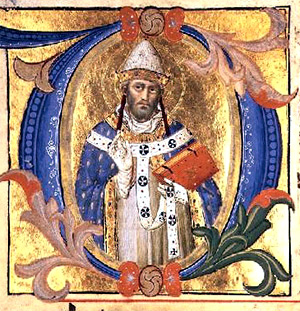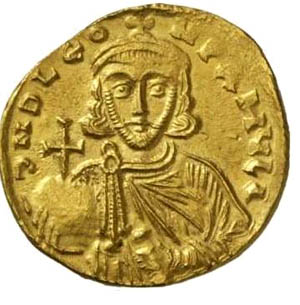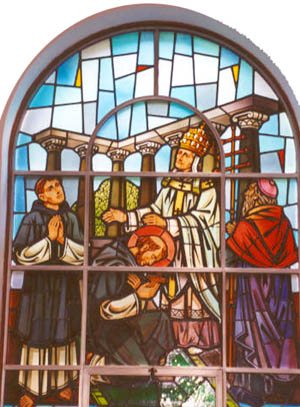 |
The Saint of the Day
Pope St. Gregory II – February 13
Prof. Plinio Corrêa de Oliveira
Biographical selection:
St. Gregory II was Pope from 715 to 731. Here is an excerpt of one of his letters to the Emperor of the Eastern Roman Empire, Leo III the Isaurian, who became an iconoclast and issued an imperial decree forbidding the use of sacred images:

Gregory II from a Florentine manuscript,
15th c.
|
“The pious Emperors were submissive to the Pontiffs of the Church and never dishonored them. You, on the contrary, since the day when you apostatized from the Faith, incurring the same curse that [in previous letters] you made against those who persecute sacred ministers and condemning yourself by your own decree, you have separated yourself from the Holy Ghost and you do persecute and tyrannize us by the hands of your soldiers and earthly weapons. We do not have weapons or armies, but we invoke the King of the whole Universe, Christ, Who is seated in Heaven over all the celestial powers and armies, to deliver you to Satan, as the Apostle says, in the flesh and the spirit.
“We are traveling to the far East to assist those who are asking for Baptism. I had already sent Bishops and priests from my Church to them. The Princes of those places have not yet been washed in the waters of the Baptism, and they have chosen me as Godfather. So, we need to be on our way, fearful lest one day God will ask an account for our negligence.
“I pray God to give you prudence and repentance so that you will return to the truth that you left and bring the people to the bosom of the Catholic Church.”
Comments of Prof. Plinio:
This letter is grandiose! What causes me enthusiasm is its militant language in opposition to that of present day false ecumenism. The Pope speaks these truths to the heretic Emperor as for a person almost without the possibility of salvation.

An 8th century coin bearing the imprint
of heretic Emperor Leo III the Isaurian
|
It shows the language that a saintly Pope should use in his relations with a heretic. He knew that the Emperor had once followed the Church but had become a heretic.
It seems that he knew even the date this happened, for he wrote: “The day on which you apostatized from the Faith…” It is a superb language, the complete opposite of the false ecumenism we witness today. An ecumenist would say: “The day on which you were diverted by another part of the evangelical truth, which perhaps you have forgotten...” But a true saint does not hesitate to say to a heretical powerful man, to an Emperor: “You apostatized.”
St. Gregory II continued: “On that day you incurred the curse you have made.” It is a magnificent militant speech, again diametrically opposed to that of today’s pseudo-ecumenism. Today, the ecumenist would say: “In your search for the truth, you denied that Christ is God. O, the different courses of human reasoning! But I know that you did this in good faith.”
By contrast, the language of St. Gregory II could not be more appropriate to denounce the errors of such false ecumenism. He wrote the Emperor: “The day on which you separated yourself from the Holy Ghost.” No one can make any stronger accusation than this. Nothing is worse than removing oneself from the Holy Ghost, because the sins against the Holy Ghost are unpardonable. Since John XXIII, this language has been abandoned because Progressivism wants to do away with the militancy of the Catholic Church.
Another anti-false-ecumenist attitude can be seen in how the Pope acknowledged that he did not have military weapons and armies, but instead of shedding tears and making laments, he reacted by exercising his spiritual powers: he cursed the heretic Emperor. “We do not have armies” he said, “but we appeal to Christ, Who is seated in Heaven over all the celestial powers and armies, to deliver you to Satan.” This language indicates a quite different climate from the pseudo-ecumenist one that dominates today. It reflects the holy militancy that has always characterized the Catholic Church. For those who may be contaminated by the virus of false ecumenism, it is good to remember that Pope Gregory II is a saint.

Pope Gregory II sends out St. Boniface to convert Germany
|
Then he writes that he will go to visit the faithful Princes who want to receive Baptism having him as their Godfather. It is a way to say to Leo the Isaurian, “I have those who listen to the call of the grace and are faithful. I will turn my attention to them, because there is nothing else to be done with you.” He does what Our Lord ordered us to do: To cut off the putrid member of the body and take care of the healthy ones.
He finishes his letter with these words: “I pray God to give you prudence and repentance so that you will return to the truth that you left and bring the people to the bosom of the Catholic Church.” In effect he is saying that the only thing that can bring these two men together is the conversion of the Emperor to the Catholic Church.
Today one would say: “We are separated brothers. We no longer share the same ideas, but we are still of one heart.” In this new Church there is no longer opposition between true and error, evil and good; instead it operates on the false presupposition that evil and good can live together and unite in a common cause. It is the opposite of Catholic doctrine, the opposite of the attitude of the saints.
Someone could object to these comments: “But this is how it was in the past. Today Catholic doctrine has changed!” I would answer: No, the Scripture says that the word of God remains the same forever. What was wrong yesterday is wrong today and will be wrong forever. God does not change, nor does Catholic doctrine.
Let us ask St. Gregory II to give us his combativeness, his discernment between truth and error, good and evil, which is a consequence of the spirit of faith, and a complete opposition to present day religious relativism.


  | | Prof. Plinio Corrêa de Oliveira | |
The Saint of the Day features highlights from the lives of saints based on comments made by the late Prof. Plinio Corrêa de Oliveira. Following the example of St. John Bosco who used to make similar talks for the boys of his College, each evening it was Prof. Plinio’s custom to make a short commentary on the lives of the next day’s saint in a meeting for youth in order to encourage them in the practice of virtue and love for the Catholic Church. TIA thought that its readers could profit from these valuable commentaries.
The texts of both the biographical data and the comments come from personal notes taken by Atila S. Guimarães from 1964 to 1995. Given the fact that the source is a personal notebook, it is possible that at times the biographic notes transcribed here will not rigorously follow the original text read by Prof. Plinio. The commentaries have also been adapted and translated for TIA’s site.
|
Saint of the Day | Home | Books | CDs | Search | Contact Us | Donate

© 2002- Tradition in Action, Inc. All Rights Reserved
|
 |

|